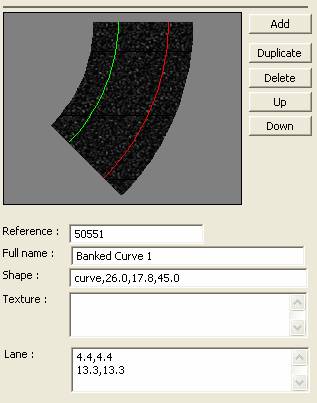
Lane syntax
The track section lanes are described using a specific
syntax in the track palette editor lane edit field:

The general lane description is either:
-
an array of
points coordinates in library units separated by any kind of separators except
points (.) which are decimal separator
-
a track
section function followed by a set of attributes
There is one line of lane description per lane (example: 2 lanes in the picture above).
The track section lane coordinate system is defined
from left to right (X axis) and from top to bottom (Y axis). Lane coordinates
are always given in library units in the track coordinate system.
The lane description can begin with the optional
fields “L, length” where length is the lane length in library units. UR30
calculates automatically the lane from its definition when these optional
fields are not specified.
Example:
L, 40, squiggle,4,11.5,10
Draws a squiggle lane (see below).
Its length is forced to 40 cm (assumes the library units is “cm” here) instead
of the length calculated by UR30.
Lane syntax is detailed below:
Standard lane
|
|
Syntax: start point, end point.
The start point is the distance from the track section top to the beginning of the lane on the left track section side.
The end point is the distance from the track section top to the end of the lane on the right track section side.
UR30 automatically manages lane shape according to the track shape.
UR30 will draw a line for a rectangle shape, an arc for a curve track section or a squiggle for a squiggle track section.
Refer to the list of track section shapes for further details about track shapes.
|
Free hand lane
|
|
Syntax: array of points in shape coordinates and library units
The points are given in library units.
UR30 automatically attaches lane segments when they are close enough. In this example, there are 4 lane segments automatically grouped by UR30 in 2 complex track section lanes.
Example of the passer pit track section (2 lanes): 4, 4 0,4,6,4,30,-3.7 -> green lane 11.5, 11.5 0,11.5,6,11.5,30,19.3 -> yellow lane
Here there are 2 lane lengths per lane because each lane divided in 2 sub-lanes.
Example of the cross track section (4 lanes): L,35.0,(0, 4.0)(35.0, 4.0) L,35.0,(0, 11.5)(35.0, 11.5) L,43.0,(11.5, -20.0)(11.5, 23.0) L,43.0,(19.0, -20.0)(19.0, 23.0) |
Chicane lane
|
|
Syntax: chicane, distance, height, strength
Attributes: - distance: distance from the track section top to the lane beginning and end points on track section left & right sides. In library units - height: specifies how depth is the chicane. A value of 0 is equivalent to a straight line. In library units - strength: specifies how smooth is the lane. If this value is 0, then the lane will be straight
Example of this track section (2 lanes): chicane,4,3,10 -> green lane chicane,11.5,-3,10 -> red lane
|
Squiggle lane
|
|
Syntax: squiggle, left distance, right distance, strength
Attributes: - left distance: distance from the track section top to the lane beginning on track section left side. In library units - right distance: distance from the track section top to the lane end on track section right side. In library units - strength: specifies how tied is the lane. If this value is 0, then the lane will be straight
Example of this track section (2 lanes): squiggle,4,11.5,10 -> green lane squiggle,11.5,4,10 -> red lane
|